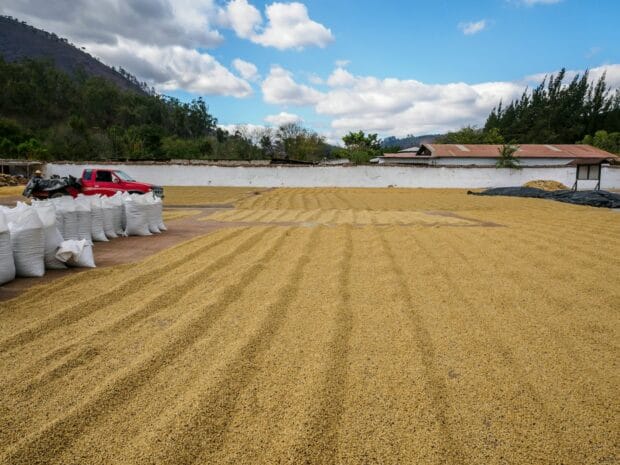[[{“value”:”
The Guatemalan national coffee association Anacafé led a comprehensive set of geographic surveys to redraw the map of the country’s coffee lands map last year.
The effort has resulted in a clearer picture of one of the world’s largest coffee-producing countries, where smallholder coffee farmers — representing 97% of the total number of growers — continue to be challenged by relatively high fertilizer costs, labor shortages and access to processing infrastructure.
These and other issues are outlined in the new USDA Foreign Agriculture Service annual report on the Guatemalan coffee sector.
[Note: This is part of a series of stories that will explore USDA FAS annual coffee reports. The information agency typically delivers more than a dozen country-level reports on the coffee sector, each coming from different authors and field offices.]
Green Coffee Production
The USDA FAS forecast for Guatemalan coffee production saw a slight decrease to 3.25 million 60kg bags, down from 3.26 million in the 2023/24 year.
Despite lower fertilization costs since the pandemic era, many farmers continue to face increased production costs, leading to issues sush as leaf rust disease and pest. These issues are being exacerbated by a lack of labor due to migration, according to the report.
Support and Programs: The Guatemalan national coffee association Anacafe is supporting producers through extension services, as well as through its ongoing Sustainable Profitability Program, designed to help coffee farmers be better entrepreneurs. There are now 21,358 hectares belonging to 3,282 producers through the program.
Guatemala Coffee Map Update
Anacafe led a comprehensive geographic survey of Guatemala’s coffee lands, resulting in a new coffee map. The map shows a total of 251,265 hectares with stable coffee plantations, 124,734 hectares of new or previously unreported plantations, and a deduction of 49,336 hectares that no longer have coffee.
Guatemala’s coffee planted area for market year 2024/25 is forecast at 376,000 hectares, with 1.6 billion mature trees and 183 million non-bearing trees. Arabica coffee continues to dominate production, at 99%.
Arabica plantations in Guatemala remain mostly under shade, with shade tree species increasing as producers aim to enter the specialty coffee market and obtain environmentally friendly certifications. Despite increases in planted and harvested areas, production has not increased, indicating a focus on quality and sustainability, the authors noted.
Yields
Guatemalan coffee production currently comes from 354 large-scale farmers (0.28% of total), 3,636 medium-scale farmers (3%), and nearly 97% smallholder farmers, with each group contributing 25%, 31%, and 44% of the harvest, respectively.
Many small-scale farmers have reduced fertilization due to costs, which the agency said is likely to impact present and future harvests.
More farmers are beginning to explore low-cost technologies in various stages of coffee production, including pruning, harvesting, and milling.
Trade/Exports
Guatemala ranked ninth globally in coffee exports in 2022/23, with coffee accounting for 8% of the country’s agro-industrial exports, making it the most significant export product. Guatemala was the fourth largest arabica exporter globally in 2022/23.
The United States remains the largest importer of Guatemalan coffee, though total exports fell by 10% in 2022/23. North America buys 49% of Guatemala’s exports, followed by Europe (26%) and Asia (22%).
In addition to coffee beans, Guatemala also exports roasted and soluble coffee. Soluble coffee exports increased by 6% in 2022/23, with El Salvador being the largest importer, while roasted coffee exports increased by 11%.
Price Realities
The report notes that because most coffee farmers lack the infrastructure to process coffee for export, they rely on intermediaries or larger farms. Larger farms pay “10% above middlemen” but require farmers to transport the coffee, further adding costs to smallholders, the report states.
Most smallholder farmers sell their coffee as cherry, earning $21-22 per 100 pounds in 2023/24, which is substantially lower than prices for parchment coffee, according to the analysis.
Anacafe told the Guatemalan post that it is concerned about the decreasing price differential between specialty and non-specialty coffee, which has dropped from over $18 to $3 per 100 pounds. The trend could disadvantage Guatemalan coffee farmers who are producing specialty coffee, according to sources in the report.
Domestic Consumption
Guatemala’s coffee consumption is expected to remain stable at 651,000 60-kilo bags in 2024/25, similar to the estimate for MY2023/2024.
Consumption in 2022/23 exceeded previous estimates by 4%, indicating a growing trend in coffee consumption in Guatemala.
Soluble coffee continues to exceed roasted ground coffee by volume share, representing 58% of total consumption.
Comments? Questions? News to share? Contact DCN’s editors here.
Related Posts
“}]]


